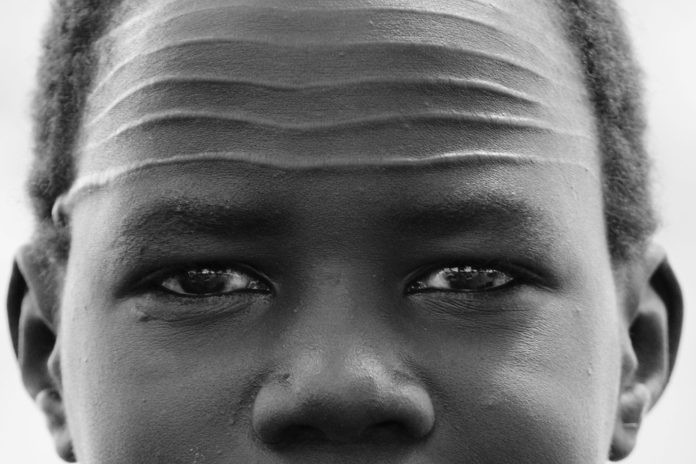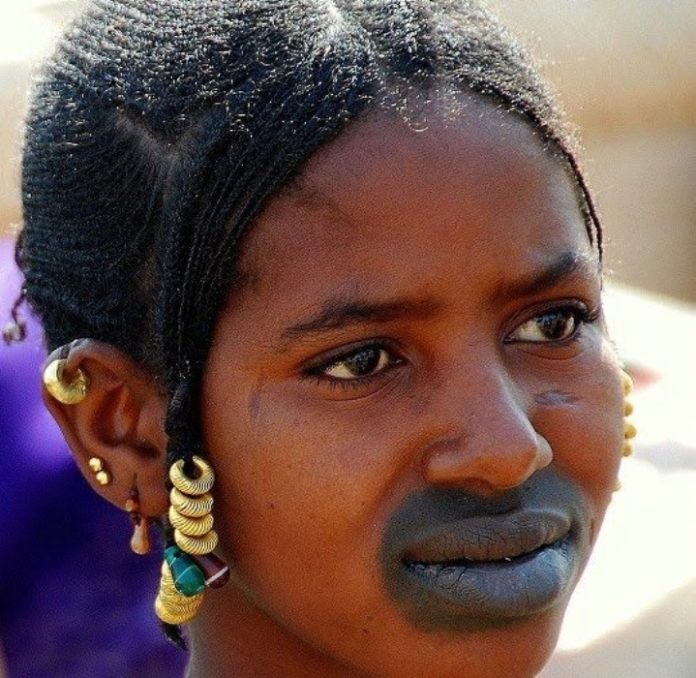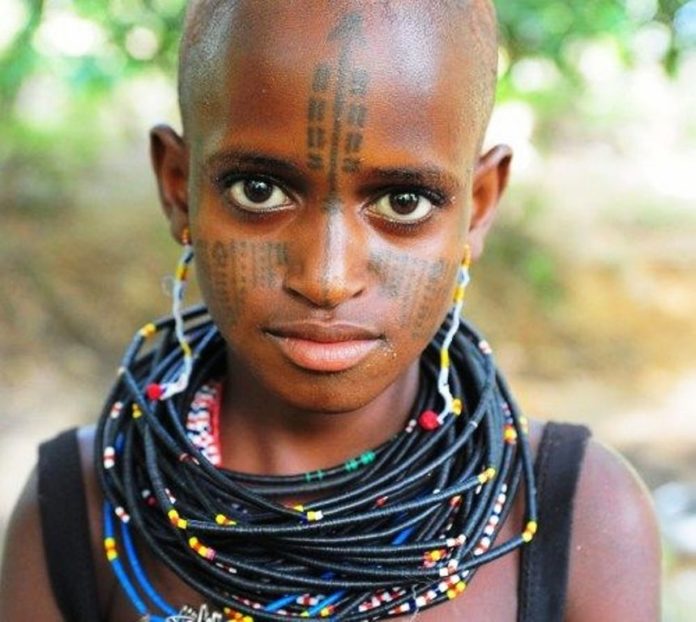Africa accounts for about 16% of the world’s human population and is the world’s second-largest and second-most-populous continent. The continent is considered the ‘cradle of humankind’ and the region that birthed many inventions and discoveries. The African tribal tattoos, the continent’s unique approach to life, and even natural bond with animals and nature are some of the things that make the region unique.
Thousands of years after tattooing of the body began in Africa, African tribes still engage in the traditional form of body art for both decorative and symbolic purposes.
Africa Is Considered The Historic Birthplace Of Tattooing
Throughout centuries, Africans prettified their bodies with permanent symbols that represented more than visible symbols. According to scientists, the North African country Egypt was the first place where the oldest evidence of purposeful and symbolic tattooing in humans was discovered. The tattoos were found on the bodies of two Egyptian mummies, believed to be more than 5,000 years old.
In Africa, tattoos are not just mere body art. Even people who draw them for decorative purposes do so with an aim or intention. North Africa holds the historical record as the continent where most people tattoo their bodies as part of religious and ritual practices. But this was not the case in Southern and sub-Saharan regions of Africa then.
The upper-class African women are also credited for spreading the tattooing practice across ancient Egypt and Northern Africa. They believed that tattoos were not just body marking but symbols of status, women’s fertility, and even worship. In ancient Northern Africa, a mere look at a person’s tattoo would tell who the person was, where his allegiances lay, as well as his social standing.
Despite The Abolishment Of Tattoos Then, The Practice Managed To Spread To Younger Generations
With the arrival of Islam in Africa, especially in Northern Africa, tattooing was slowly abolished. The religion saw the practice as a form of self-mutilation and a great sin before God. However, tattooing managed to spread to the younger generations across Southern and Central Africa, where a form of tattooing called Scarification began spreading, especially among young girls.
Unlike the earliest method of using the ancestral ink on the body, Scarification involves carving symbols and patterns into the skin. Like tattoos, which were believed to be used in curing illness, providing protection, showing loyalty to one’s tribe, and denoting social status, scarification was also believed to be a sign of beauty, womanhood, giving protection and marking a significant moment in one’s life.
The practices of tattooing and scarification are still being practiced in present-day Africa. In fact, the two are now blended into called “cicatrization.” The term means a deeply symbolic and personal method of marking the skin in the form of scars.
The scars are subsequently raised with the addition of soot or ashes into the wound. The scars are usually carved as symbols that represent emblems of spiritual protection and coming-of-age rituals. These markings become a source of pride and a reflection of a person’s incredible endurance and determination as he ages.
African Tribal Tattoos and Their Meanings
Here are 30 African tattoos and their meanings. Most of the tattoos on our list are symbolic, while others are for decorative purposes.
African Tribal Tattoos For Men
1. Bitta Village Scarification
This African tribal tattoo is unique to men in Bitta village, in Omo Valley, Ethiopia. There are about 88 tribes in Omo Valley, situated in southwestern Ethiopia. In Bitta, it is common to see men with tribal tattoos in the form of scarification.
People in Omo Valley scarify their bodies with different designs and for different purposes and meanings. For men, these tattoos symbolize strength and courage, and the practice continues even after they have given birth to their first child, unlike women who end their scarification practice after giving birth to their first child.
A tattooed man in Bitta is seen as a brave and powerful man. Such men are greatly respected and celebrated as a hero.
2. Elephant Tattoo
The elephant tattoo is more symbolic than decorative. In South Africa, elephants symbolize strength and power. So, men who wear elephant tattoos are seen as being powerful, stable, firm, and sound.
Some men wear the elephant tattoo for decorative purposes. An elephant is greatly revered and admired for its noble qualities such as stamina, loyalty, longevity, wisdom, mental faculties, and even size.
3. Egyptian Horus Eye Tattoo
The Horus eye is an Egyptian tattoo that symbolizes protection, rebirth, healing, and rejuvenation. According to Egyptian myth, Horus was an Egyptian god who lost his left eye in a struggle with another god called Seth.
However, the eye was magically restored by the goddess of the sky and love Hathor, a process that later became known as an act of making whole and healing. The Horus eye is often used in amulets as they are highly symbolic.
4. Nuer Gaar Tattoo

This Nuer boy with a facial marking called Gaar represents strength and tribal ownership. The tattoo is symbolic as it is a common initiation pattern carved on males as part of their initiation into adulthood. There are various Nuer scarification patterns, and each subgroup has a distinct pattern.
However, the most common tribal tattoo is the one that consists of six parallel horizontal lines which are cut across the forehead with a razor. The lines above the nose are usually carved to have a dip. The Nuer tribe is one of the largest ethnic groups in South Sudan, East Africa.
African Tribal Tattoos For Women
5. Ladybug Tattoo
Women wear the ladybug tattoo for both symbolic and decorative purposes. In South Africa, the ladybug or ladybird symbolizes good fortune, talent, protection, healing, evolution, and grace. You could see a ladybug surrounded by beautiful flowers in the picture above. Many women find the ladybug tattoo attractive and appealing.
6. Malian Tchoodi Tattoo

This is called the Tchoodi tattoo. It is a Fulani black lip tattoo that symbolizes beauty and courage. It is equally a cultural identity and ritual performed exclusively by women in Mali, West Africa.
The tradition of tattooing the lips black serves as a right of passage and signifies that girls have achieved womanhood. The tattoo makes women more attractive to men, and those who do not have it are mocked or considered an outcast.
7. Ghanaian Duafe and Dwennimmen Adinkra Tattoo
The image above contains two Adinkra tattoos, which are gotten from the Adinkra symbols. The tattoos above are the Duafe symbol, represented by a wooden comb, and Dwennimmen, represented by two colliding ram horns. The wooden comb symbolizes femininity, good hygiene, love, and care, while the two colliding ram horns symbolize inner power, strength, humility.
The Adinkra symbols were initially created many years ago by the Gyaaman clans of the Brong region in Ghana. Today, the Adinkra symbols are also used on logos, fabrics, and pottery. They are also popular sources for tattoos.
8. Ghanaian Adinkra Symbols Tattoo
Yet another Adinkra masterpiece, the image above is an Adinkra tattoo with four revered symbols of the Akan people. The symbol at the top is called Biribi Wo Soro, which symbolizes Hope. Sankofa is the name of the symbol sitting between the two heart-shaped symbols.
Sankofa is a stylized heart shape that means “go back and get.” It signifies the importance of learning from one’s past to prepare for the future. Sankofa is also represented by a bird with its head turned backward.
The two heart-shaped symbols are called nyakonpon adom nti, symbolizing hope, providence, faith. Finally, the ring-like symbols are called Nyasapo. It is a knot tattoo representing patience, wisdom, ingenuity, intelligence. The tattoo above is purely symbolic, and the designs are so great.
9. Makonde Palm Fronds Tattoo
This is a scar tattoo that is common among Makonde women in Mozambique. Tattoos in the region are done for various purposes, including initiations and rituals. The tattoo ritual signifies courage and “To Show, I am a Makonde.”
Nearly all tattooed Makonde men and women have scars across their facial area, particularly around their cheeks, mouth, and nose. The palm fronds motif is commonly used for the design.
Dinembo is the general Makonde term for the tattoo, and the tattooing process requires three or more sessions with the tattoo design artist to produce the desired result.
Zulu African Tribal Tattoos
10. Zulu Shaka Zulu Tattoo
This is a Shaka Zulu tattoo. Shaka Zulu was a prominent chief and founder of South Africa’s Zulu Empire. He is greatly revered among the Zulus and symbolizes unity.
Most people wear the Shaka Zulu for decorative purposes and as a way of identifying with his personality and noble qualities of greatness, bravery, courage, and determination.
African Warrior Tattoos
11. Half-Animal And Half-Human Warrior Tattoo
This is an African warrior tattoo that depicts courage and bravery. The tattoo is mainly decorative, while the intention of choosing the tattoo largely depends on the wearer.
West African Tribal Tattoos
12. Tampegre Stomach Tattoo
This stomach tattoo or scar is unique to the people of Tampegre, Benin. The markings on their body are both symbolic and for decorative purposes. However, they are more symbolic and basically show where a person is coming from.
There are so many designs of the scars in the region. However, the scars on the image above are symbols of Fayenfe, the god of war and death. The marks seem to suggest the idea of a series of bars that perhaps prevent evil spirits from entering them.
The people believe that women who have stomach scars bear more children than those who don’t have them, while people who die with the scars are recognized by their ancestors or tribe after their death.
13. Camel Tattoo
This is a decorative tattoo. Camel was a significant means of transportation in Africa, especially North Africa, in the olden days. However, things began to change after they started trading the animals and other things with people from West Africa and other regions. Camels generally symbolize pilgrimage, hope, journey, wealth, persistence, and abundance.
14. Yoruba Kolo Tattoo
The Yoruba and Ije regions of Nigeria and Benin also have unique scar tattoos. There were different designs of these tattoos, which are carved for various reasons.
The image above is a symbolic tattoo of a woman with extensive scars. Apart from beautification, these markings are carved before a woman gets married and before giving birth to a baby.
15. Chambri Crocodile Scarification
This is a picture of crocodile scarification practiced among the Chambri people of Papua New Guinea. It is done during the tribal initiation of boys into manhood. It is not mere beautification; instead, it is highly symbolic. The tribal tattoo tends to demonstrate dedication, discipline, and focus.
16. Tampegre Facial Tattoo
Facial marks in Benin is symbolic as it indicates one’s tribal membership. Again, in places like Tampegre, they believe a man will find things difficult in life and be denied initiation into his tribe if he is not scarred. The traditional procedure, which is usually done with a thin blade, has several patterns. The lines suggest growth, which is important in life.
African Tribal Leg Tattoos
17. Ghanaian Adinkra and African Map Tattoo
This particular tattoo is both symbolic and for beauty at the same time. The Ghanaian lady’s right leg is beautified with the African map, while her left leg shows one of the Adinkra symbols, Aya. Aya is represented by a fern, and it symbolizes resourcefulness and endurance.
18. Ghanaian Adinkra Symbols Tattoo
This is a highly symbolic Adinkra tattoo with 12 symbols. From the top of her right leg to the bottom are the Nyame Nti (which symbolizes faith and trust in God), Osram Ne Nsorroma (which symbolizes faithfulness, love, and bonding in marriage), Odo Nnyew Fie Kwan (which indicates the power of love), Nyame Dua (which represented God’s protection and presence), Nya Gyidie (which symbolizes hope and faith), and Akoko Nan (which symbolizes discipline and nurturing)symbols.
From the top of her left leg to the bottom are the Aya (which symbolizes endurance and resourcefulness), Nyansopo (which symbolizes patience, intelligence, wisdom), Asase Ye Duru (which symbolizes power, divinity, providence, Ge Nyame (which means Nothing but God), Dwennimmen, and Akoben (which represents wariness and vigilance) symbols.
19. Lion Tattoo
This African tribal tattoo is purely for beautification. In Africa, the lion is greatly admired for its noble qualities such as strength, courage, authority, pride, and wisdom.
African Tribal Armband Tattoos
20. Ghanaian Sankofa Adinkra Tattoo
This is an Adinkra tattoo with the symbol of Sankofa. The Akan, Ghanaian word, Sankofa, means “retrieve.” As clearly shown above, the symbol is a bird with its head turned backward while its feet face forward, carrying a precious egg in its mouth. Sankofa signifies the importance of learning from your past and preparing for the future.
21. Stag Tattoo
This stag tattoo is for beautification purposes. The stag is an animal that is unique for its maturity, stamina, regeneration, virility, and instincts.
22. Bird Tattoo
This is another tattoo that is not drawn for symbolic purposes. The wear intends to beautify her body with the art. Africans revered birds because they believed the animals bring fertility.
23. Floral Tattoo
This floral tattoo is not a symbolic one. However, it passes across relevant meanings. Flowers represent hope.
24. Owl Tattoo
This owl tattoo is purely for the decoration of the body. Owls are seen as being evil in most regions in Africa.
25. Nature-Inspired Tattoo
This is a decorative tattoo that is nature and travel-inspired. It is the wearer that knows his intention of choosing this beautiful African-inspired tattoo.
26. Panda Tattoo
This is a Panda-inspired decorative tattoo. In most African tribes, pandas are known for conservations.
27. Tiger Tattoo
The tiger represents protectiveness, speed, feminine power, beauty, and aggression in most African tribes. This particular tattoo is not symbolic but for decorative purposes.
African Tribal Chest Tattoos
28. Egyptian Lotus Flower Tattoo
This is an Egyptian lotus-inspired tattoo. In Egypt, the lotus symbolizes rebirth. This tattoo is symbolic and also beautifully adores the chest of the wearer.
29. Ghanaian Aya Adinkra Tattoo
This is an Adinkra symbol chest tattoo. This Adinkra symbol, created by the Akan tribe of Ghana, symbolizes resourcefulness and endurance. This tattoo is symbolic.
30. Lotus Flower Tattoo
This is a lotus decorative tattoo. The flower signifies creation and spiritual enlightenment.
African Tribal Tattoos Seem To Be Highly Symbolic Than Decorative
Regardless of civilization, African tribal tattoos are still being rocked by people worldwide. Indeed, African tribal tattoos seem to be highly symbolic than decorative. Most people who wear these tattoos for decorative purposes mostly do so as a form of story-telling and self-expression.
However, most African tribal tattoos are unique and represent spiritual meanings, beliefs, traditions, statuses, traits like strength, hardships, courage, unity, endurance, love, and more, depending on where one is coming from. Some tattoos also serve as an inspiration and a source of respect for things like landscape, wildlife, and nature.
In conclusion, every piece of ink (whether decorative or symbolic) has potential history and meaning. African tribal tattoos are powerful choices and highly impactful.
